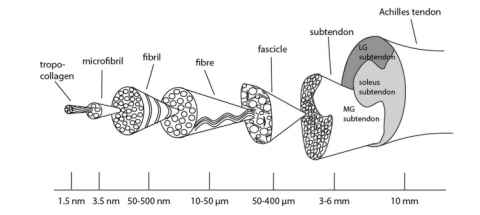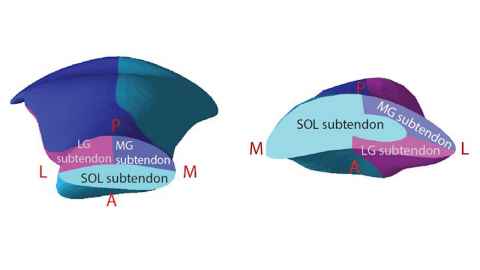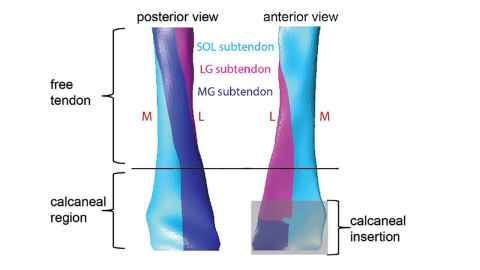Tendon Mechanics
Tendons are the stiff collagenous connective tissue that link muscle to bone, transmit the energy of movement to the skeleton, and store elastic energy to be released to enable powerful or periodic movements.
In recent years, there has been an explosion of discoveries in tendon anatomy and mechanics. Our group has been using imaging and computational modelling to contribute to an understanding of the form and function of tendons and their role in the musculoskeletal system.

Our research
Our group has expertise in advanced MRI and cutting-edge finite element modelling of biological soft tissues. Technical development of these methods and application to the tendons has led to a deep anatomical and biomechanical understanding of several features of the human Achilles tendon including: 3D structure of Achilles subtendons, subtendon sliding, fascicle torsion, and the contribution of muscles to tendon mechanics.

We are furthering our technical capabilities using MRI and are engaged in a research programme to image the fascial network in vivo using MRI and modelling the biomechanics of the fascia using finite element analysis.

Applications of this work include rehabilitation from tendinopathy, surgical planning, optimising athletic training, and promoting fitness and activity into old age.
Members
Funding partners
- Marsden Fund, Royal Society of New Zealand
- Aotearoa Fellowship, Robertson Foundation
Publications
- Handsfield, G., Slane, L., & Screen, H. (2016). Nomenclature of the tendon hierarchy: An overview of inconsistent terminology and a proposed size-based naming scheme with terminology for multi-muscle tendons. Journal of biomechanics, 49(13), 3112-3124.
- Handsfield, G. G., Inouye, J. M., Slane, L. C., Thelen, D. G., Miller, G. W., & Blemker, S. S. (2017). A 3D model of the Achilles tendon to determine the mechanisms underlying nonuniform tendon displacements. Journal of biomechanics, 51, 17-25.
- Shim, V. B., Handsfield, G. G., Fernandez, J. W., Lloyd, D. G., & Besier, T. F. (2018). Combining in silico and in vitro experiments to characterize the role of fascicle twist in the Achilles tendon. Scientific reports, 8(1), 1-12.
- Shim, V. B., Handsfield, G., Fernandez, J., & Besier, D. L. T. (2017, March). Fibre torsion in the Achilles tendon reduces stress concentrations and improves tissue strength. In 2017 Annual Meeting of the Orthopaedic Research Society.
- Handsfield, G., Inouye, J., Slane, L., Thelen, D., Miller, W., & Blemker, S. (2015). Image-based finite element modeling of the Achilles tendon: The role of fascicle morphology and muscle forces in non-uniform tendon displacements. In Abstract Book.
- Pizzolato, C., Lloyd, D. G., Zheng, M. H., Besier, T. F., Shim, V. B., Obst, S. J., ... & Barrett, R. S. (2019). Finding the sweet spot via personalised Achilles tendon training: the future is within reach.
- Shim, V., Fernandez, J., Besier, T., & Hunter, P. (2012). Investigation of the role of crimps in collagen fibers in tendon with a microstructually based finite element model. In 2012 Annual International Conference of the IEEE Engineering in Medicine and Biology Society (pp. 4871-4874). IEEE.
- Joo Kim, J., Musson, D. S., Matthews, B. G., Cornish, J., Anderson, I. A., & Shim, V. B. (2016). Applying physiologically relevant strains to tenocytes in an in vitro cell device induces in vivo like behaviors. Journal of biomechanical engineering, 138(12).
- Pizzolato, C., Shim, V. B., Besier, T. F., Devaprakash, D., Barrett, R. S., & Lloyd, D. G. Combined EMG-informed neuromusculoskeletal and surrogates of FE models estimate localised Achilles tendon strain in real-time.
- Shim, V., Fernandez, J., Gamage, P., Regnery, C., Hunter, P., Lloyd, D., & Besier, T. (2014, July). INFLUENCE OF GEOMETRY AND MATERIAL PROPERTIES IN ACHILLES TENDON RUPTURES. In Orthopaedic Proceedings (Vol. 96, No. SUPP_11, pp. 265-265). The British Editorial Society of Bone & Joint Surgery.
- Hansen, W., Shim, V. B., Obst, S., Lloyd, D. G., Newsham-West, R., & Barrett, R. S. (2017). Achilles tendon stress is more sensitive to subject-specific geometry than subject-specific material properties: a finite element analysis. Journal of biomechanics, 56, 26-31.
- Shim, V. B., Hansen, W., Newsham-West, R., Nuri, L., Obst, S., Pizzolato, C., ... & Barrett, R. S. (2019). Influence of altered geometry and material properties on tissue stress distribution under load in tendinopathic Achilles tendons–A subject-specific finite element analysis. Journal of biomechanics, 82, 142-148.